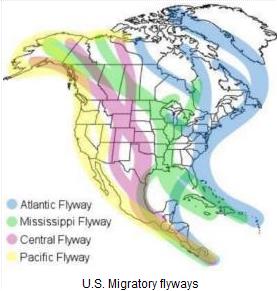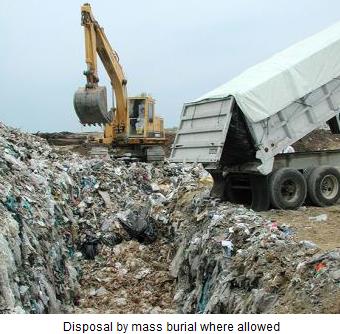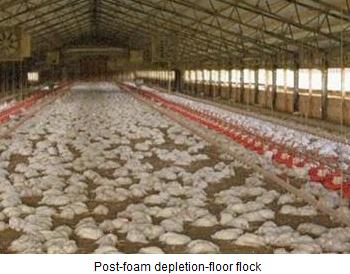|
Subscribers are directed to an excellent opinion article* on resurgence of avian influenza virus authored by Drs. Michelle Wille and Ian Barr of the University of Sydney, Australia. Information on the evolution of the Goose/Guangdong lineage extending to the current 2.3.4.4 pathogen as discussed conforms to material presented in a recent webinar by Dr. David Swayne of the USDA-ARS National Poultry Disease Research Center.
 Epidemiological evaluation subsequent to the 2014-2015 epornitic demonstrated the role of migratory waterfowl in the introduction and dissemination of HPAI, emphasizing the need for preemptive surveillance. Following trans-Atlantic introduction of the Eurasian H5N1 strain into the Maritime Provinces of Canada in late 2021 USDA-APHIS activated a program of sampling hunter-killed ducks. This demonstrated the presence of H5N1 virus in the Atlantic, Mississippi, and Central Flyways during the first quarter of 2022, with indirect evidence of virus shedding in the northern segment of the Pacific Flyway. Lessons learned during the 2014-2015 epornitic, led to enhanced biosecurity precautions that may have lowered the risk of infection in many areas with a high density of commercial poultry. Epidemiological evaluation subsequent to the 2014-2015 epornitic demonstrated the role of migratory waterfowl in the introduction and dissemination of HPAI, emphasizing the need for preemptive surveillance. Following trans-Atlantic introduction of the Eurasian H5N1 strain into the Maritime Provinces of Canada in late 2021 USDA-APHIS activated a program of sampling hunter-killed ducks. This demonstrated the presence of H5N1 virus in the Atlantic, Mississippi, and Central Flyways during the first quarter of 2022, with indirect evidence of virus shedding in the northern segment of the Pacific Flyway. Lessons learned during the 2014-2015 epornitic, led to enhanced biosecurity precautions that may have lowered the risk of infection in many areas with a high density of commercial poultry.
The types of farms and species of poultry affected in 2022 show some differences from 2014-2015. Many more backyard flocks, frequently the index cases in affected counties, were infected suggesting the widespread dissemination of H5N1 virus. Although a few very large egg production complexes were affected in both epornitics, it is evident that a number of potentially at-risk farms have been spared, suggesting that protective biosecurity measures have been effective. An outstanding observation relating to the 2022 outbreaks is the predominance of commercial turkey flocks, far exceeding the number and their distribution in 2015. Large outbreaks in Iowa and Nebraska have occurred in the same counties or even the same complexes confirming risk factors such as proximity to wetlands and rivers and possibly correlated with possible predisposing deficiencies in biosecurity. The 2022 U.S. epornitic has also involved commercial ducks paralleling the situation in France.

The poultry industries in North America require updates on risk factors relating to introduction of infection, including duration of shedding by migratory waterfowl and other species, persistence of the virus in the environment and specific routes of introduction into commercial turkey, egg and broiler farms with reference to possible deficiencies in either structural or operational biosecurity. Despite requests, USDA-APHIS has not provided any interim guidance based on available epidemiologic data collected following each outbreak. Both observational and molecular information is required together with a provisional but logical interpretation of data in order to provide practical suggestions to enhance prevention.
The Science article referenced considers the possibility of H5N1 clade 2.3.4.4 becoming zoonotic. Public health considerations relating to HPAI are obviously of extreme importance. The current risk is considered to be extremely low for the population of Europe as evaluated, even for those subject to occupational exposure. The World Health Organization and the OIE continue to monitor outbreaks of HPAI in poultry and wild birds and through member nations surveillance is extended to potentially exposed populations. The Science article specifically noted that deploying an inactivated H7N9 vaccine in poultry destined for wet markets in China reduced the incidence rate of human infection from 759 cases in 2017 to only two cases in 2018.
Currently, industrialized nations are following eradication policies, although inactivated vaccines have proven successful in suppressing mortality in outbreaks in Italy and Mexico. Consideration must obviously be extended to new-generation vaccines as it is apparent that poultry industries worldwide will be subjected to more frequent panornitics given the extensive distribution of evolving viruses that have become endemic among migratory birds.
 It is an unfortunate reality that HPAI is no longer a once-in-a decade event localized to specific areas. The approach to ‘eradication” of an exotic infection applying traditional measures will in the future be ineffective and expensive accepting the possibility of seasonal introduction. The approach to controlling the 2022 epornitic in the U.S. is no different to the more localized outbreak in 1984. The USDA-APHIS and their counterparts in Europe have upgraded procedures and logistics and expedited the control sequence comprising rapid diagnosis, flock depletion, disposal and decontamination, quarantine with zonal surveillance. A new approach is required since HPAI is no longer exotic but seasonally endemic. The poultry industry is now faced with mass shedding of virus over large areas with both H5 and H7 strains potentially undergoing genetic drift in concentrations of migratory birds and mutations in large localized populations of commercial poultry. HPAI is no longer a regional or national issue and the inevitability of recurrent panornitics will require a radical re-evaluation of control, prevention and trade policy at both national and international levels. Eradication is not a viable option so regulatory approaches should consider alternatives to the traditional approach to introduction of HPAI. It is an unfortunate reality that HPAI is no longer a once-in-a decade event localized to specific areas. The approach to ‘eradication” of an exotic infection applying traditional measures will in the future be ineffective and expensive accepting the possibility of seasonal introduction. The approach to controlling the 2022 epornitic in the U.S. is no different to the more localized outbreak in 1984. The USDA-APHIS and their counterparts in Europe have upgraded procedures and logistics and expedited the control sequence comprising rapid diagnosis, flock depletion, disposal and decontamination, quarantine with zonal surveillance. A new approach is required since HPAI is no longer exotic but seasonally endemic. The poultry industry is now faced with mass shedding of virus over large areas with both H5 and H7 strains potentially undergoing genetic drift in concentrations of migratory birds and mutations in large localized populations of commercial poultry. HPAI is no longer a regional or national issue and the inevitability of recurrent panornitics will require a radical re-evaluation of control, prevention and trade policy at both national and international levels. Eradication is not a viable option so regulatory approaches should consider alternatives to the traditional approach to introduction of HPAI.
*Wille, M. and Barr, I. Resurgence of Avian Influenza Virus. Science 376: 459-460. (2022).
|